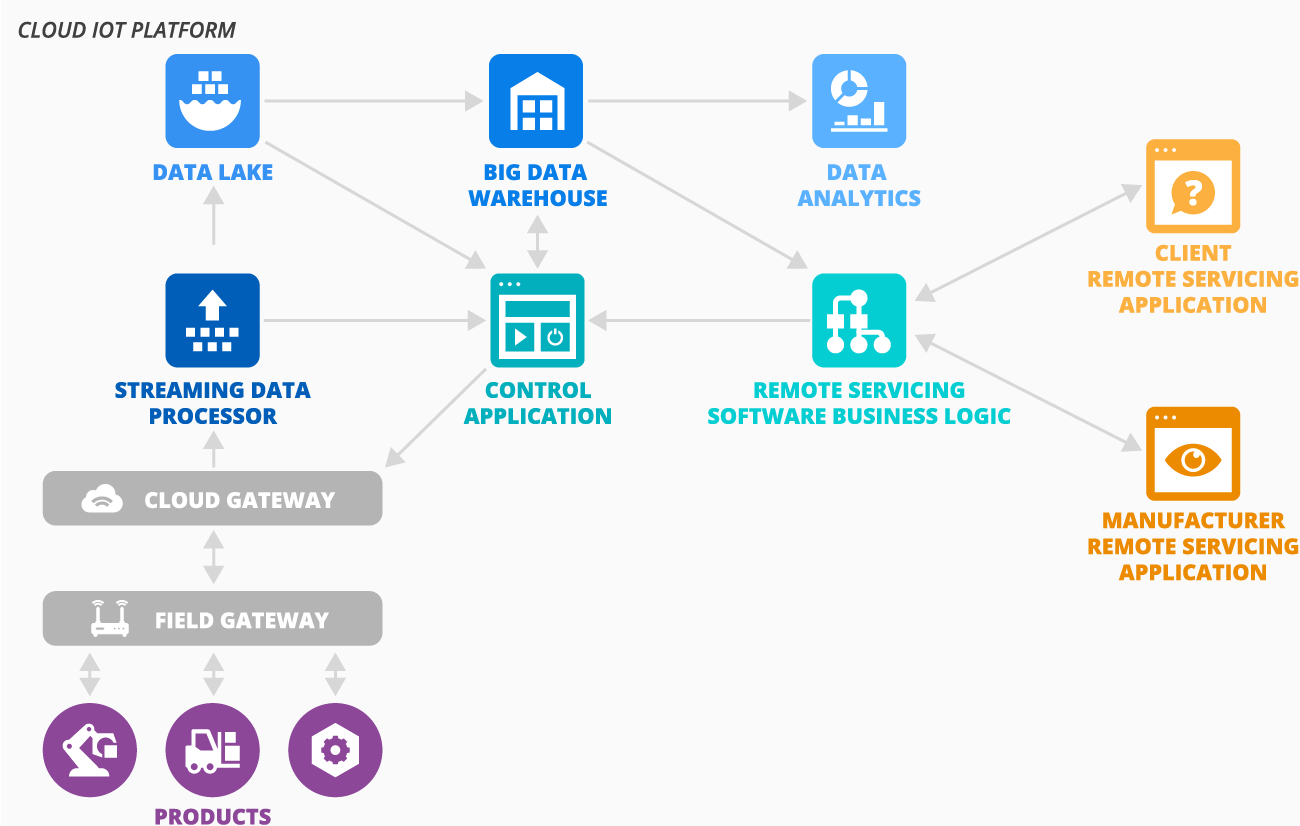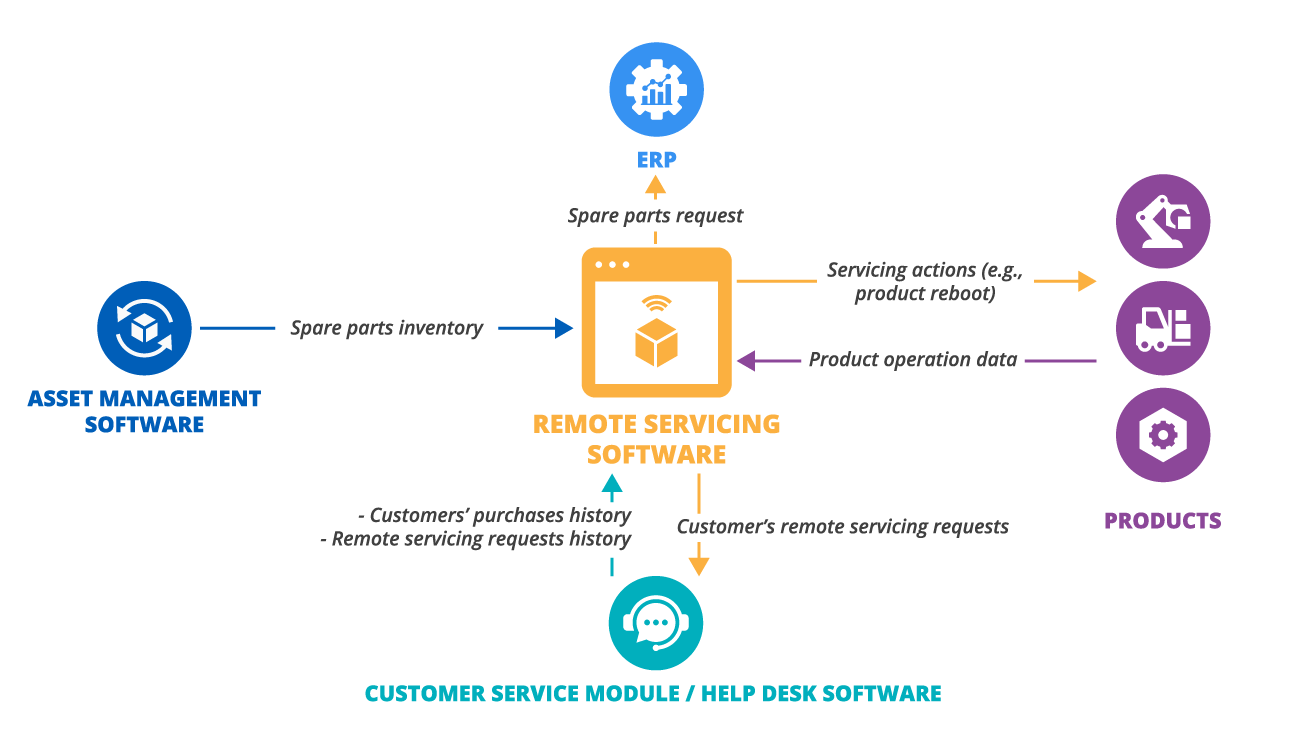Remote Service Software
Benefits, Architecture, Features, Integrations
Having 14-year experience in developing IoT solutions, ScienceSoft offers robust solutions for remote servicing of complex manufactured products.
Remote Servicing Software: the Essence
IoT-enabled remote service software helps manufacturers of equipment*, machines*, and complex devices* monitor their products and provide after-sales product support and maintenance at the customer sites. Such solutions often integrate with a manufacturer’s asset management software, ERP, and customer service module.
* – further referred to as “products”.
Benefits of Remote Service Management
|
|
Industries Using Remote Servicing
Remote servicing can be utilized by manufacturers that create products for the following industries:
Manufacturing
Servicing of machining centers, casting machines, etc.
Construction
Servicing of tower cranes, mobile construction cranes, etc.
Oil and gas
Servicing of drilling equipment, rod pumping units, etc.
Logistics
Servicing of trucks, forklifts, etc.
Healthcare
Servicing of computed tomography scanners, MRI scanners, etc.
Supply chain
Servicing of lifting equipment, hoists, etc.
The Architecture of Remote Servicing Software
Remote servicing assistance software is designed to cater to multiple customers of a product manufacturer. The solution architecture comprises the following elements:

- Products (e.g., production machinery, medical equipment) with sensors to enable data collection for product monitoring and actuators to initiate servicing actions (e.g., product reboot).
- Field gateways to provide connectivity, preprocess, filter, and transfer data from the products to the cloud, transmit control commands to the products.
- Cloud gateway to facilitate data compression and secure data transmission between field gateways and the cloud IoT server and ensure compatibility with various product connectivity protocols.
- Streaming data processor to transfer the input data to a data lake and control applications.
- Data lake to store the large amounts of unstructured data generated by connected products.
- Big data warehouse to store structured data needed for the analysis of product operations, context information about products and environment, etc.
- Data analytics to gain actionable insights, e.g., by identifying trends in product use and operation (e.g., product operating at low capacity).
- Control applications to send commands to actuators installed in the products (e.g., machining centers) to initiate certain actions (e.g., start or stop the engine).
- Remote servicing software business logic to transmit commands from the manufacturer’s servicing app to the control application and display collected and analyzed product data to users (technicians on the customer’s and the manufacturer’s sides).
- Client remote servicing application to enable users on the customer’s side (e.g., support technicians, field operators and engineers) to access a remote servicing system, create service tickets, view the product’s operating parameters, etc.
- Manufacturer remote servicing application to monitor products’ operation, detect issues, remotely configure the products, apply security patches, collect remote service requests from customers, etc. The manufacturer sees all the connected products (split by customer).
The Functional Scope of Remote Service Software
Based on ScienceSoft’s experience in similar projects, we outline a common functionality set for remote servicing software:
Remote device servicing
For a manufacturer’s technicians.
- Product search (by product ID, state, type, etc.).
- Product hierarchy arrangement to group devices according to their functions, applicable security policies, etc.
- Setting up and adjusting product operation instructions for customers.
- Handling remote product reboots, resets, diagnostics, and troubleshooting.
- Firmware updates (e.g., to patch security vulnerabilities, enhance product functionality).
- Warranty management of the supplied products (e.g., create a warranty, fulfill warranty).
Product monitoring
For the manufacturer and customers.
- For the manufacturer: real-time monitoring dashboards with an integrated view of controlled products, featuring the total number of products, number of product types, product groups.
- For customers: product performance and warranty view.
- Environment condition monitoring (e.g., temperature, humidity).
- Alerts to the manufacturer and the customer on abnormal product behavior (e.g., increased engine temperature) and operation patterns.
- Automated servicing scheduling in case of a detected issue.
- Continuous security monitoring.
Product self-servicing
For a customer’s technicians, operators, etc.
- Registering a new product.
- Product knowledge hub (product specifications and documentation, product operation instructions).
- Submitting a product servicing ticket in a client app or via contacting the manufacturer’s help desk.
- Tracking a servicing ticket status and notifications on remote servicing start and end.
- Notifications on upcoming product maintenance schedule (e.g., to plan the construction schedule accordingly).
Product data collection and analytics
For the manufacturer and customers.
- Real-time analysis of product’s performance data analysis (for technicians on the client side – data on the customers’ products, for technicians on the manufacturer’s side – all products) and its collection for further advanced analytics.
- Machine learning functionality to identify patterns leading to potential malfunction.
- AI-based identification of options for optimized product utilization (e.g., improve the use of machine capacity, minimize service breaks).
- Customer feedback surveys (on the product, on the remote servicing procedures, etc.)
Security
- Backup of product data (e.g., use history, operation time, operating parameters, operation environment parameters) in the remote servicing system and data recovery.
- End-to-end encryption.
- Multi-factor user authentication.
- Role-based remote product access.
- Tunneling to create a secure connection session with the product.
- Identification of suspicious commands of control apps that may be evidence of a security breach.
Consider Remote Servicing Software?
With 14 years of IoT expertise and 36 years in software development, ScienceSoft is ready to bring to life efficient remote servicing software for the products you manufacture. With established project management practices, we give #1 priority to project goals regardless of time and budget constraints.
Important Integrations

To provide smooth device service, ScienceSoft recommends integrating remote servicing software with:
- Asset management software for an integrated view of the available spare parts for a faster product repair in case of a hardware issue.
- Customer service module or help desk software to register the customers’ servicing tickets (created in the client remote servicing app) in the manufacturer’s customer service system and ease the communication between the customers and service technicians.
- ERP to streamline order placement for spare parts necessary for product repairing.
Success Factors of Remote Servicing Software
With 14-year experience in IoT projects, ScienceSoft's consultants have defined a set of factors, which help get value from remote servicing software fast.
Big data analytics
to identify product working patterns and use analytics insights to optimize the efficiency of manufactured products and drive the R&D (research and development) process.
Intuitive UX of the client remote servicing application
allowing customers to create new service requests fast, have convenient access to their products’ operating parameters on a dashboard, etc.
Why Choose a Custom Remote Service Solution
ScienceSoft recommends that you opt for custom remote servicing and tech support software if you want to implement:
|
|
Predictive product maintenance to enable early detection of product issues and decrease engagement of servicing technicians in routine tasks (e.g., firmware updates, security patch application). |
|
|
Usage-based pricing to charge customers for the actual use of products’ functions. |
Remote Servicing Solution Implementation
ScienceSoft brings in 14 years of experience in IoT to provide you with a remote product support and maintenance solution (featuring an IoT platform with data storage, streaming, analytics modules, an app for your technicians, and an app for the customer’s technicians).

About ScienceSoft
ScienceSoft is a global IT consulting and software development company headquartered in McKinney, TX, US. Since 2011, ScienceSoft has been leveraging IoT development services to power businesses with tailored remote servicing solutions. Being ISO 9001 and ISO 27001 certified, we rely on a mature quality management system and guarantee that the service software we develop does not pose any risks to our clients’ data security.
